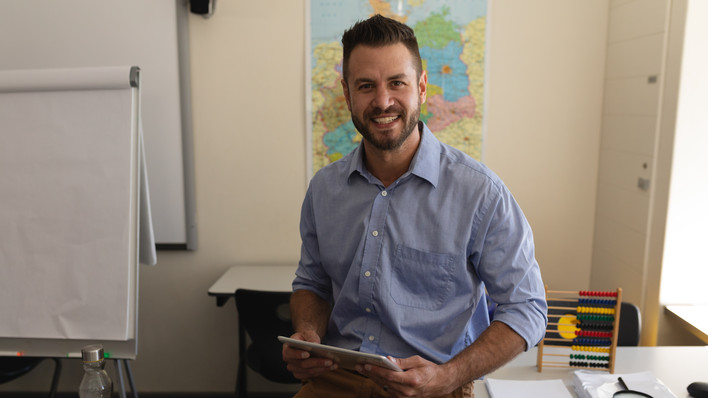When Susan McClarty’s district made the switch to open educational resources, the 6th- and 7th-grade science teacher at Centennial Middle School in Broken Arrow, Okla., initially struggled to find quality materials aligned with the Next Generation Science Standards. “We were kind of wading through water, trying to create something out of nothing,” she said.
But last school year, her school participated in a field test for a new, open-source middle grades science curriculum: OpenSciEd. The units were easy to use and emphasized hands-on discovery, she said, and using them took the pressure off of teachers to shape a coherent curriculum.
McClarty is one of the many teachers who have found it difficult to find materials that answer the NGSS’ call for science instruction based on questioning and discovery.
Now, OpenSciEd is slowly rolling out one of the first full, OER curricula that claims alignment to these standards. Three units are currently available to the public: 6th-grade thermal energy, 7th-grade metabolic reactions, and 8th-grade sound waves. All three were rated high quality by the peer review panel at Achieve, a nonprofit organization that helped states write the NGSS.
OpenSciEd, backed by funders including the Bill and Melinda Gates Foundation and the Carnegie Corporation of New York, plans to release the remaining units in groups of three every six months. The full sequence is projected to be out by winter 2022.
Twenty states and D.C. have adopted the NGSS since they were unveiled in 2013. The standards flip the traditional model of science on its head: Instead of memorizing facts, students ask questions about why the world around them works the way it does. Through this questioning, students discover the principles of science that explain these phenomena.
For example: the OpenSciEd unit on sound waves doesn’t start by explaining what a sound wave is. Instead, it asks a question: Why do car windows vibrate when the stereo is turned up?
NGSS still requires teachers to cover content: physical science, life science, earth and space science, and engineering. But lessons are also supposed to draw connections between these subjects, exploring big ideas about the way science works. These “crosscutting concepts” include themes like cause and effect, systems, and patterns.
Students are also building the skills that scientists and engineers rely on, like planning and carrying out investigations and analyzing and interpreting data. These three dimensions — disciplinary core ideas, crosscutting concepts, and science and engineering practices — are supposed to be integrated across the curriculum.
“Students are engaged in the practices as they learn the disciplinary core ideas — and they use those crosscutting concepts as a lens to really understand what is happening with that phenomena, or what is happening with that design problem they’re trying to address,” said Matt Krehbiel, Achieve’s science director. The requirement that these three dimensions work together is partly why materials have been so hard to develop.
A consortium of creators, led by the nonprofit curriculum developer BSCS Science Learning Team and the Next Generation Science Storylines Project out of Northwestern University, started work building OpenSciEd materials in 2017. As part of the development process, OpenSciEd ran field tests with teachers in 10 states during the 2018-19 school year.
“There’s a lot of companies that are putting a sticker on their old curriculum that [says] they meet the new standards,” without actually changing any of the content or philosophy, said Kris Grymonpre, a 7th- and 8th-grade teacher at John W. McCormack Middle School in Boston who participated in the pilot.
OpenSciEd’s lessons feel different, he said. “I don’t ever tell kids the answer … . It’s all about, ‘What do you think?’ Let’s get the students’ ideas up on the board.”
Focus on inquiry
Each OpenSciEd unit begins with a phenomena that sparks student inquiry, and centers at least one of each of the crosscutting concepts and science and engineering practices. Life science, physical science, and earth and space science topics are distributed throughout each of the grade levels. The curriculum is sequenced so that content knowledge builds and links back to previous topics, creating a “connecting tissue” across units and years, said James Ryan, OpenSciEd’s executive director.
The initiative currently has funding to complete the 6th-8th-grade curricula, said Ryan, and eventually hopes to design a full K-12 offering.
Achieve’s peer review panel rated all three units available now as high quality, an “incredibly high bar” to clear, said Krehbiel. Of the more than 250 units from a variety of OER publishers that the group has reviewed, only 14 — including the three OpenSciEd units — have received this designation.
Designing a curriculum centered on inquiry that addresses all three NGSS dimensions fully is quite a challenge. EdReports, a national nonprofit curriculum reviewer, has evaluated six full sets of commercial science materials. Only one has met their requirements. (The organization evaluates only full curricula, and hasn’t reviewed OpenSciEd.)
The major problems? Often, curricula don’t spell out how they’re integrating or assessing the three dimensions, said Sam Shaw, the director of science reviews at EdReports.
And while phenomena may be present, they’re not always driving instruction.
“If [the phenomenon is] positioned solely for engagement at the beginning of the lesson, and kids move on to activities that aren’t related to that phenomenon, they’re never actually figuring it out or having the opportunity to utilize the three dimensions in context,” he said.
Teachers who participated in the OpenSciEd field tests noted the materials’ coherence. Grymonpre, the Boston teacher, was impressed by the throughline of science and engineering practices in the pilot unit on sound waves: Early in the unit, students make a model of how they think a speaker works. They continue to alter it as they learn, and end the unit with a working model. “That’s exactly what the new standards want,” he said.
‘Paradigm shift’
OpenSciEd also provided professional development during the pilot — a step that was critical to teachers’ being able to use the materials well, said Maria Citrin, a 7th-grade teacher in Boston Public Schools.
“I don’t know if kids are really going to get into this,” Citrin remembered thinking on her first day of training in summer 2018. She wasn’t sure that one phenomenon — how some cups are better than others at keeping hot drinks hot and cold drinks cold — could carry students’ interest through an entire unit on thermal energy.
“The trainer kept saying, ‘Trust the process, you’ll see where this is going to go,'” Citrin said.
Field-test teachers completed an initial four-day, in-person professional development, with two-day follow-ups for each new unit. The sessions are meant not only to walk teachers through individual lessons, but to develop an understanding of science as a process of inquiry, said Katherine McNeill, a professor of science education at Boston College who led the design of the PD.
By the end of the training, Citrin said, she was excited about a question-driven classroom. Her students were invested, too, once they realized their curiosity could shape the day’s lesson. “You cannot tell us the answer!” Citrin remembered their saying during one experiment in which the class investigated why food coloring moved at different speeds through liquids of different temperatures.
The teacher-training instructions are also open-source, and will be released concurrently with units. Still, it takes time and planning to implement PD that expects so much change in teachers’ practice, said Rebecca Morales, the science instructional specialist in the Broken Arrow district. When Morales introduced OpenSciEd tools to teachers in the district who weren’t involved in the pilot, she started by just showing videos of instruction and having conversations. “This is such a paradigm shift that it takes eating very small bites of the elephant,” she said.
And even with a free curriculum, there are still financial considerations for implementation, said Mary Starr, the executive director of the Michigan Math and Science Leadership Network, the OpenSciEd lead for the state. Michigan is using grant and leadership development funds to build up a group of professional learning experts who can train teachers on the curriculum. But Starr worries that nationally, schools and districts might not use the money saved on curriculum to invest in robust PD.
Paying to print workbooks and assemble materials kits for hands-on experiments also involves cost, she said. “There’s some amount of shifting of labor [from] purchasing from a publisher, where you would be able to purchase a whole set … and it would be delivered on your doorstep.”
![]()



